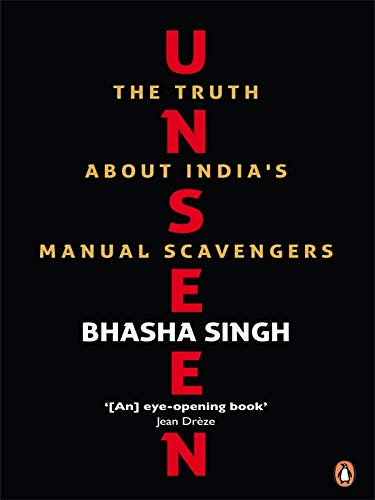Unseen: The Truth About India’s Manual Scavengers is an ethnographic account on manual scavengers by Bhasha Singh, a journalist who began covering stories on the practice in 2003.
Soon, Singh wanted to understand the various facets of this practice. She spent a decade travelling across 11 states, capturing the working and living conditions of manual scavengers. The result was a comprehensive narrative that goes beyond statistics and talks about the lives of those she rightly calls the ‘unseen’.
The book, published in 2014, was originally written in Hindi and was later translated into English by Reenu Talwar.

‘Unseen: The Truth About India’s Manual Scavengers’, Bhasha Singh, Penguin, 2014.
The book starts with a powerful foreword by Bezwada Wilson, activist and founder of the Safai Karmachari Andolan. As he points out, the book covers aspects beyond the murky waters of caste or religion. The apathy of the government, the judiciary and the bureaucracy are clearly outlined. It is commendable that the author has bravely taken the names of popular politicians of the time.
The foreword is followed by an introduction by Catarina de Albuquerque, the first United Nations Special Rapporteur on human rights, who emphasises that such practices lead to abandonment and isolation. Apart from physical harassment and violence, the gendered and generational trauma cannot be conveyed by data.
Singh notes that her struggles in getting these stories published as a journalist also highlights the indifference of media. Editors and her peers constantly rejected her work and she was labelled ‘the manual-scavenging journalist,’ she says.
The book makes the case that the media is also a part of the nexus that ensures that the ‘unseen’ remain so.
To De-caste
The chapter ‘How I became a manual-scavenging journalist’ stands out. Bhasha Singh acknowledges that the process has challenged and changed her notions about caste and Hinduism. She accepts that she has been ignorant despite being surrounded by people practising casteism in the crudest form – something she too is guilty of.
Singh says that it is essential to ‘de-caste’, i.e., to lose one’s caste identity to understand the trials and tribulations of those who must work as manual scavengers. Sharing food is a tool she has used to establish trust with interviewees.
Using the debate between Gandhi and Ambedkar, she emphasises that the community is not waiting for pity or kindness but wants to be liberated from this terrible practice. Her criticism of Hinduism is based on the fact that the caste system has ensured that there exist sub-castes even among Dalits, therefore leaving no scope for unity among those most deprived.
Part one of the book titled ‘Invisible India’, is divided into several chapters worth of accounts on wages, living conditions, and tools used to carry excrement by the manual scavengers.
Part two, named ‘Knocking on the doors of power’, covers the legal and historical aspects of the practice. The second part also deals with manual scavenging in the Indian Railways. The author has used secondary data like the Census of 2011, Union Budgets from 2003 to 2013 and Railway Budgets to highlight her claims. Survey reports by the National Commission for Safai Karamcharis, and the Safai Karmachari Andolan have also been used. This also points to the dearth and reliability of official data.
At the beginning of each chapter, a state map with the demographic details of the number of manual scavengers in each district is also an eye-opener on how rampant the practice is.
Also read: On Being a Young Dalit Woman
The following are some of the points made in the book that leap out.
- In Kashmir, it is primarily men who carry out the task of manual scavenging. They are paid the lowest wage in the country, around Rs 100 per month.
- Chapter two is about Delhi. The author cannot fathom that the practice continues in the country’s capital – right where the parliament, where the Act banning manual scavenging was passed in 1993, stands.
- Workers find it difficult to switch professions because they belong to the Dalit community. Singh’s account raises important questions on whether rehabilitation is the solution.
- When it comes to Bihar, along with caste-based oppression, women are victims of domestic violence, often perpetrated by drunk husbands.
- The West Bengal government, formed by Mamata Banerjee’s Trinamool Congress, contrary to their ideology, has shown no concern for the working poor. In Singh’s interaction with local MLAs, she finds that they were unaware of schemes and provisions in place to curb manual scavenging.
- The fifth chapter, about Haryana, highlights that women and men alike cannot enter pools of human excreta without using intoxicants like tobacco or liquor. Thus children of the community have also begun using them.
- In Uttar Pradesh, manual scavengers clean toilets on credit, which the household paid later when they had enough to spend. Thus there is a disparity between two types of poor – the poor privileged by their caste are not victims of this occupation.
- The account of Gujarat calls out Narendra Modi, former chief minister of the state, and his Hindutva ideology, which has ensured that all development appeased his vote bank: the ‘upper’ caste and class.
- Ironically, women in Rajasthan were generally not allowed to go out of their homes but were asked to set out early in the morning and late at night to pick up human waste.
- In Madhya Pradesh, manual scavengers consider each colony or house they work in as a legacy inherited from their parents or in-laws. This inheritance is only passed on to daughters and not to the men in the family. Perhaps this is the only form of property that a Dalit woman is entitled to own.
- The stories of women in Andhra Pradesh highlight the community’s efforts to end this practice. Led by Cherukutotta Narayanamma, workers burned their baskets and broke the dry latrines of the colonies when politicians and bureaucrats failed to listen to their pleas.
- Part one of the book ends with a chapter on Karnataka, where a similar awakening within the community led to people questioning and abandoning this practice.
Also read: The Dawn of Dalit-Led Media and Journalism
Women
In the author’s words, “Women are the Dalits among the Dalits”.
Her focus on women brings to light several health-related problems they suffer, right from allergies, and skin diseases to miscarriages and breathing problems. They skip their meals and avoid yellow dal, a primary source of protein in households after working hours. Women in the profession hate the smell of their bodies and hair to the extent that some scrape their skin with knives. They have no identity, other ‘dabbu-wali’ or ‘tokri-wali’.
Discrimination faced by children is also common.
While some have accepted manual scavenging as their fate, many strongly wish to break this cycle of oppression and be reborn as “humans”. There is a strong desire to liberate children from this caste-based oppression, the book finds.
A political presence
The second part of the book begins with the chapter ‘A foot in the door’ and talks about the struggles of the community when it came to raising a case in the Supreme Court.
The author also explained the drawbacks and limitations of The Employment of Manual Scavengers and Construction of Dry Latrines (Prohibition) Act, 1993. Why did it take 17 years for all the state governments to approve it?
The discussion on manual scavenging in the Indian Railways speaks loudly about the authorities’ apathy. The flaws in their suggested alternatives to dry toilets portray their disregard for those belonging to the Dalit community.
Would caste hierarchies disappear after introducing modern or flush toilets, the author wonders. The book asks why colonies, where manual scavengers live, are far from cities and extremely filthy. It asks if loans would be of any help if people do not buy anything from shops of Dalits. Do Dalit leaders have a say in the political system? These and many more are everyday concerns raised by Dalit people themselves.
The book, however, tackles only 11 states and leaves out northeastern states.
The book’s simple language goes a long way toward explaining the gruesome reality of our social, economic, political and legal systems.
Gloves and gumboots are not the solutions. The eradication of the practice is what manual scavengers want.
Snigdha Sony is a journalism graduate from Delhi University and is currently pursuing an MA in Development Studies from Ambedkar University, Delhi.
Featured image: Denny Müller / Unsplash

